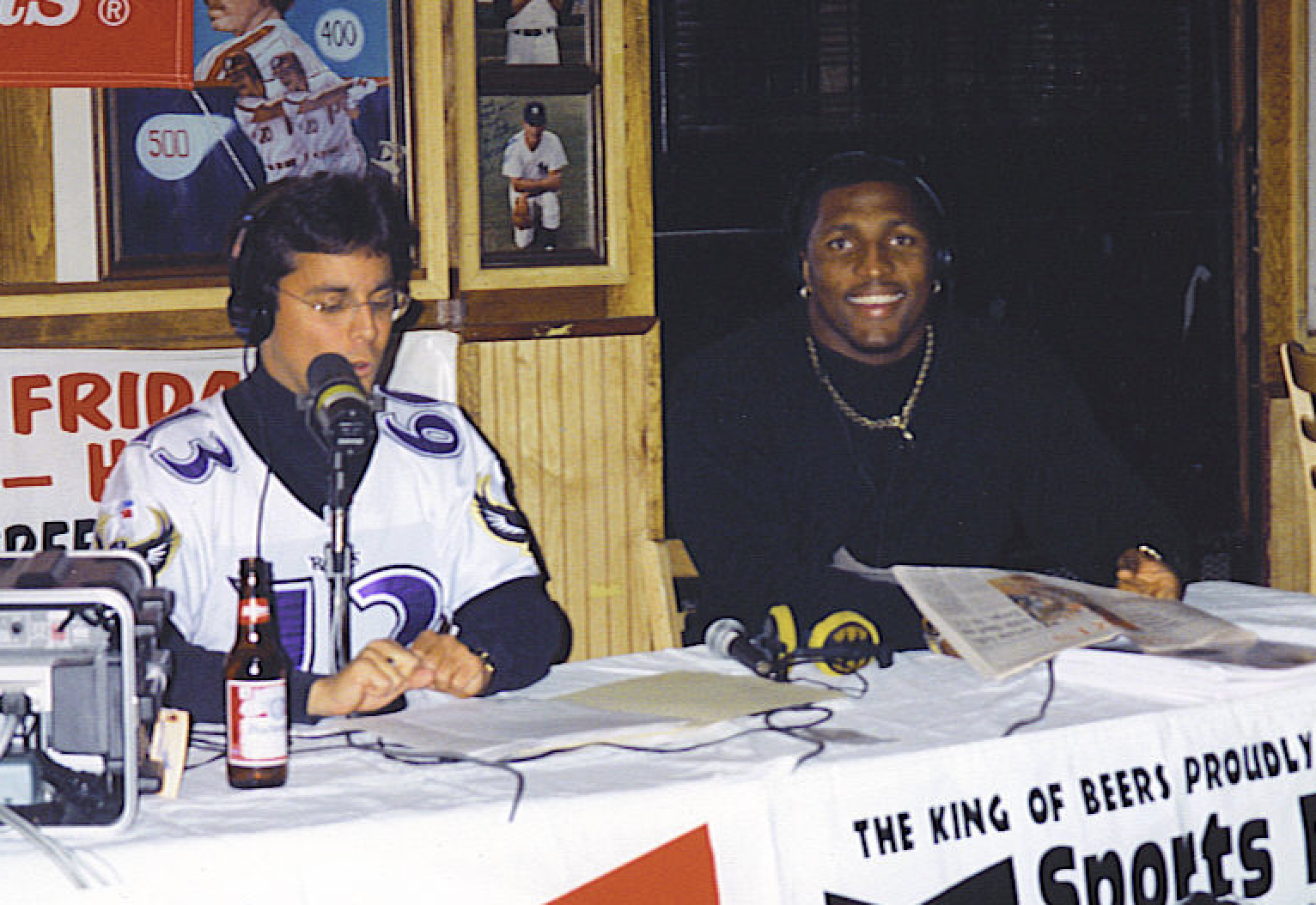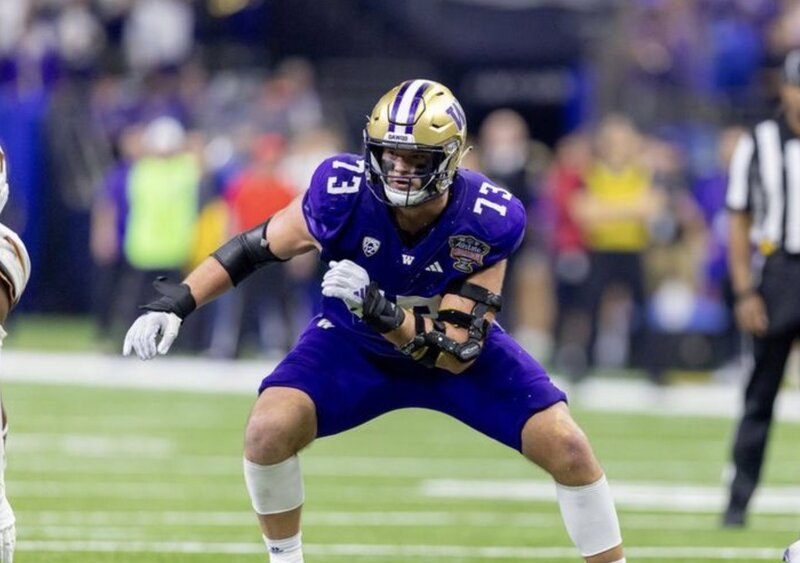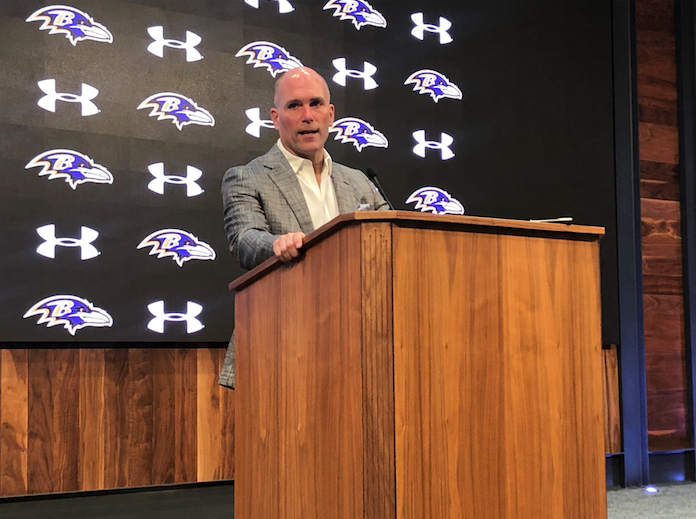“I view myself as one of the more physical tackles in the game, the kind of guy who loves to hit you in the face, knock you to the ground and fall on you.”
– Jonathan Ogden to Sports Illustrated, January 2001
“When Ray (Lewis) hits a guy, you can hear the air go out of him. Before the game it’s hysterical – opposing backs will come over and try to buddy up to him, like that will make him take it easy on them.”
– Tony Siragusa to Sports Illustrated, January 2001
THE PHONE THAT WAS BEING shown on national television was very simplistic.
White phone. Black logo. Nondescript font. No color scheme. No logo. Not even a hint of a logo.
BALTIMORE RAVENS is all it said.
The ESPN audience of Mel Kiper groupies would be tuning in to see the future of the NFL unfolding on Draft Day, April 20, 1996. There was the phone, along with a hat of similar non-distinction, on a table in the middle of the Paramount Theatre. Amidst a sea of tradition and color and fanfare that only Draft Day can provide, Ravens equipment manager Ed Carroll presided over the team’s first draft in New York City that day awaiting the word from the war room back in Baltimore about whose name to submit to NFL commissioner Paul Tagliabue.
Only time brings clarity to these situations and decisions. Before the day was over the franchise would take a pair of future Hall of Famers, left tackle Jonathan Ogden and linebacker Ray Lewis.
Six days later, Carroll would become their new best friend in the organization, making sure they had pads, tape, protectors and most importantly, a jersey and helmet when leaving the clubhouse.
Six days later, the team formerly known as the Cleveland Browns took to a shoddy practice field in Owings Mills, Md., for the first mini-camp as the Baltimore Ravens. Of the more than 60 players who participated in that camp, only kicker Matt Stover, defensive end Rob Burnett, defensive tackle Larry Webster, and wide-eyed rookies wide receiver Jermaine Lewis, offensive tackle Spencer Folau, Ogden and Lewis would still be around to celebrate a Super Bowl championship in Tampa in January 2001. Two others, running back Earnest Byner and special teams ace Bennie Thompson, would be part of the organization as members of the coaching staff. Just one coach, defensive coordinator Marvin Lewis, would still be in place in Tampa to hoist the Lombardi Trophy.
When the team took the field that day under new head coach Ted Marchibroda, it looked more like a jailbreak than an NFL team. Literally.
That weekend the assembled group of original Ravens – wearing an ensemble devoid of any colors, tradition, markings or logos – forever became known as the Mean Machine.
Just like Burt Reynolds in the early 1970s movie, “The Longest Yard,” a drama pitting a prison football team against the outside world, the Ravens were wearing plain white helmets and a plain white jersey with black numbers and no names.
It was good enough for Burt, but it wasn’t conducive to making anyone feel like they were still in the NFL in 1996.
“It was a little surreal coming over from Pittsburgh with all of the tradition,” said Marvin Lewis, who was three months removed from coaching the linebackers of the Pittsburgh Steelers in Super Bowl XXX in Tempe, Ariz. “Here were all of these NFL players out on the field with no identity at all. Even the coach’s gear they gave me was all plain black and white. I can’t imagine there’s been anything like it in the history of the NFL.”
The only distinguishing characteristic of the uniforms was a bright red Riddell logo for the manufacturer of the helmets, stuck smack dab above the eyes of the players.
“When I got drafted I didn’t even get a jersey with my name on it,” Ogden told a group of reporters at the Super Bowl five years later. “They gave me a black jacket with RAVENS written in white on the back. If you had asked me back then – hell, even two years ago – if we would be in the Super Bowl now, I would’ve said a lot of things would need to change for that to happen.”
So just how did they get from that field that day in black and white to wearing the purple jerseys signifying the World Champions?
The two best answers all came in the same day: Jonathan Ogden and Ray Lewis.
Other players will come and go in the organization. More championships may fill the cupboard of Baltimore football fans in the future. But in the hearts of the fans, there are only two Ravens that can ever be called “original Ravens,” and that’s Ogden and Lewis. No disrespect to any of the others, that’s just the way that it is.
That said, you probably couldn’t find two more opposite personalities.
Ogden, a giant of a man at 6-8, 350 pounds, is quiet, book smart, articulate, as simple and as unassuming as any man of his size can be.
Lewis, a sculpted 6-1, 252 pounds, is the life of the party, smiling, surrounded by people, complex, friendly to a fault, and perfectly comfortable in the spotlight.
Ogden wears jeans and sweat suits.
Lewis wears only the finest tailored suits from the pages of GQ magazine.
But the common bond they share and all of the same days of hard work, sweat and dedication will forever have them linked to the first Super Bowl championship of the Baltimore Ravens.
Let’s start with Ogden, who won the Outland Award in his senior season at UCLA and was one of the most highly touted offensive linemen in the history of the game. It’s easy to get lulled into indifference regarding the enormous left tackle because his craft is usually performed away from the ball and his assignment rarely gets involved where the naked eye sees a play. Much like officiating in sports, if you don’t notice it then it must be good.
It didn’t take long to get a glimpse at the greatness of Jonathan Ogden. The first sign came four games into the Ravens’ first season. While rolling ahead of a block against New Orleans, with Byner carrying the ball, Ogden got in front of the veteran running back and proceeded to outrun him into the Saints’ secondary. Here was a gigantic natural tackle, playing the left guard position, moving into an NFL defense with the speed of an outstanding fullback, ready to blow up tiny safeties and cornerbacks. Ogden actually had to stop and wait for Byner to catch up, before the back gained 42 yards on the play.

In 1997, his second season, he switched to his natural left tackle position and has been voted to the Pro Bowl in all four of his opportunities since.
Don’t mistake his cool Southern California, UCLA demeanor off the field for softness. On Sundays, it becomes rage and fury.
“I don’t know why, but I enjoy physically trying to rip people on the football field,” Ogden told The Washington Post. “I enjoy trying to hit and head-butt them and punch them and slap them. I love that stuff.”

































